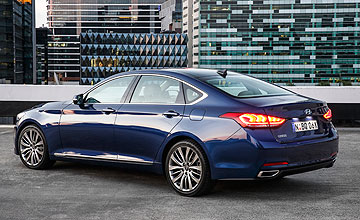BY TIM ROBSON | 6th Nov 2014

The winged moniker we can take or leave – it looks like an understyled version of an Aston Martin logo – and the ‘3.8’ badge on the bootlid is an odd thing to promote, but it’s good to see the Hyundai badges proudly in place. The standard car wears 18-inch rims, while the top-spec Ultimate rides on handsome 19-inch wheels with wider 275mm rubber out back and 245mm tyres on the front.
Our first experience was in the rear seats, as we were transferred to a hotel. The rear pews are wide and deep, and – in the top model, at least – are heated. There are climate controls and, for the mischievous at heart, controls for the front seat at hand, should you desire some more leg room.
Our short ride is quiet and amazingly smooth, and both exit and entry are very easy thanks to a large door aperture. While there’s a lap/sash belt for a centre rear passenger, the seat itself is very narrow and looks damn uncomfortable.
Slide in behind the steering wheel, and it’s a view that you’ve not seen before in a Hyundai product. The large 9.2-inch screen dominates the centre console, while the button array below is restrained and nicely underdone. The centre-mounted clock looks like an anachronism, but despite its retro appearance, it’s actually updated via GPS signal.
The interior design is simple, elegant and sufficiently modern, with a variety of materials contrasting to give the car a real sense of quality.
There are plenty of buttons on the steering wheel and to the driver’s right. It’s an environment that takes some getting used to, in fact – many functions are hidden in sub-menus on the four-inch centre screen in the centre of the dashboard cluster. Indeed, some functions – including disabling various safety modes like lane departure warning, for instance – require the car to be stopped before they can be changed.
The steering wheel is perhaps a little ye olde worlde, but its rim is thick and comfortable underhand.
The 3.8-litre V6 fires up quietly via a starter button and recedes into the background a result of considerable efforts to reduce NVH levels throughout the car. An extra 38kg of sound deadening has been added to this gen-two Genesis, for example, and the Ultimate also uses acoustic deadening glass to further reduce ambient noise levels.
Snick the firm shifter into D, and the Genesis eases away regally, the wheel light under your hands at low speed. It’s not keen to be hurried away from the line blame its almost two-tonne mass for that. It does react more wilfully when the Sport button is used to quicken the shifting and sharpen the throttle, but it’s not a car that’s destined to win drag races.
On open, flowing roads, the efforts of the Australian localisation program are borne out with a primary ride that’s as compliant and cosseting as any car we’ve tested.
The Genesis almost glides over sub-average road surfaces at the national speed limit, though the rear end feels noticeably more fluid and prone to rushing through its travel than the front end.
With 19 damper specs tested for the rear end alone, along with months of international discussions about how to achieve the perfect blend of ride and handling out of a long-wheelbase, two-tonne sedan, the Genesis at times feels like there’s still a final element of the ride equation that’s missing.
There’s a surprising amount of body roll in evidence, while the rear end’s behaviour isn’t as resolved as the front. Its steering feel is amazingly good, though, especially at speed, and the brake pedal is high, firm and well modulated.
At urban speeds, the Hyundai is, quite frankly, astonishingly competent.
Whisper-quiet, with sufficient – if not overwhelming – power and torque to hand, great visibility and lovely steering, the Genesis would make an ideal mid- to long-distance commuter vehicle.
The boot space is restricted, though, and it’s a disappointment that the rear seats can’t be lowered to make more load space. This, of course, would mean that the vault-like chassis feel would be compromised, and that’s not a trade-off that’s worth making.
The Ulimate Spec car’s acoustic glass makes a quiet car even more serene and silent again, though the top spec car’s extra 105kg weight disadvantage blunts its acceleration.
With a vast array of passive and active safety technology aboard, the Genesis still manages to feel like a driver’s car in the main. There’s a healthy measure of being connected to the road via the seat of your pants, which is no mean feat in a five-metre long, almost-two-tonne sedan.
It’s quiet, comfortable, and solid. It’s not especially economical we saw returns of around 12.5 litres per 100km against an official figure of 11.2L/100km, though we weren’t being delicate of foot. It did, however, drop markedly on highway runs, showing figures in the low nines.
It’s impossible to say if the Genesis will be the success story that it should be, based on this first impression. With an industry-leading 75,000km/five-year free servicing plan, a five year/unlimited km warranty and roadside assist package (not to mention agreed-price buyback deals for leasers), it ticks the logical boxes.
The car itself – a handsome, capable and considered luxury sedan that is truly world-class – also manages to tug at the emotions.